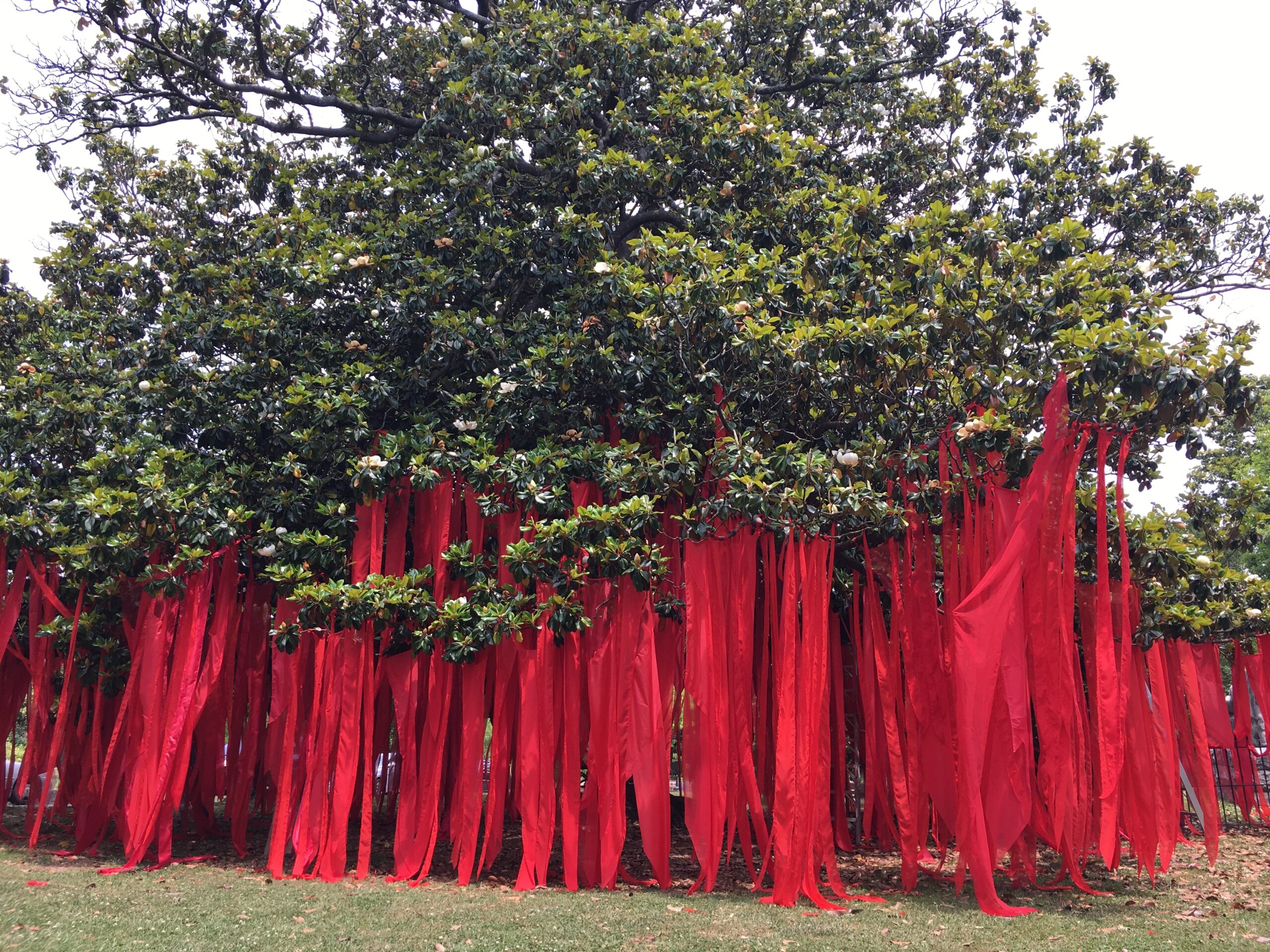Artists Ring In ‘Golden Hour’ At Oakland Cemetary

Hundreds of long red pieces of fabric are tied to the branches of an old magnolia for Sara Jimenez’s Cenotaph.
Myke Johns / WABE
While the city outside doesn’t exactly disappear inside Oakland Cemetery’s gates, the traffic and the trains running by do take on a more muted tone among the mausoleums and monuments. That’s where Oshun Layne, a New York-based artist is guest curating for the “Golden Hour,” being presented by the Arts at Oakland and Dashboard US.
Arts at Oakland is precisely what it sounds like: a program to put up works of art at Oakland Cemetery. They have partnered with the rouge gallery collective, Dashboard US, to put on a show that ties the work to the place.
In a clearing not far inside the front gates, are there are a group of art works, including a giant wooden disk, propped up by what looks like a flagpole sticking through its center.
“This piece is actually a 24-hour sundial which will work throughout the course of the day,” she explains.
This functional sculpture is the work of artists Ben Coleman and Henry Detweiler. The outlandish size of the thing makes for a humorous commentary on the idea of time.
“Uhh, who has time for that?” Layne chuckles. “In the cemetery, everyone that’s here, they’ve got all the time that you could possibly imagine.”
Oshun is from Brooklyn, but she spent some of her college years here in Atlanta, so she was familiar with Oakland. When she was asked to curate this exhibit here, she says her mind immediately went to her own funeral.
“The only song I want played is ‘Golden Time of Day’ by Frankie Beverly and Maze,” she says. “And ‘Golden Time of Day’ is talking about that hour, that sunset, that sunrise…walking into a new chapter, leaving a chapter. And I thought, ‘what a perfect space to have that conversation.’”
With some of the works, that conversation is meant to be taken literally.
Atlanta artist Karen Tauches’ piece, “Dead Letters” is meant to evoke both a temple and a run-down post office—one where visitors can reach out to their loved ones in the afterlife. Tauches seems to be having fun with bringing her work outside of her usual gallery environment.
“I’m using the same materials,” Tauches says. “I always work with light and photography. So I’ll be projecting an image of the wind moving through a field, to bring home the idea of communication through the air, but in a spiritual way.”
“Golden Hour” includes the works of 14 different artists in 11 works of site-specific art. That diversity of voices makes for a wide variety of interpretations of the theme of the passage of time and the transition from life to death—from Detweiler and Coleman’s literal time piece to steel-and-neon sculptures by InKyoung Chun. Having the work here in Oakland—which already feels a little bit like a museum—the pieces are meant to both blend in and stand out.
“How many people, this is their run for the day?” Layne asks. “Or they’re gonna walk their pets. They have their routine…we’re breaking up the routine. And I’m more than thrilled to see what that looks like, and the smiles and the ‘can I touch? Can I not touch?’ I feel like everyone becomes a little bit of a kid because they don’t know the rules and regulations yet. But they quickly start to pick up and then they’re like ‘oh I can go do this!’”
It’s the sort of engagement that wouldn’t happen in quite the same way inside of a gallery space. And the works themselves tend to work with the environment in ways that would only work in a place like Oakland Cemetery. One stunning example of this is New York artist Sara Jimenez’s work “Cenotaph.” Walking past the towering Confederate Obelisk, the work jumps from the landscape—hundreds of long red pieces of fabric, tied to the branches of an old magnolia tree next to the Lion of Atlanta statue.
Jimenez says her idea for the piece came after reading about the 2016 discovery of almost 900 unmarked graves belonging to African Americans there at Oakland. The Historic Oakland Foundation is working on identifying the remains.
“One of the things that I noticed was that in the Confederate section, there already is this giant stone sculpture which memorializes the remains of unmarked Confederate soldiers, and yet there isn’t anything commemorating these remains in the African American section,” Jimenez says.
“I wanted to create a kind of memorial that showed the amount of those that have been unnamed and forgotten. So hanging from this magnolia tree which is right next to the Lion are 872 abstracted red inverted obelisks.”
In addition to the works themselves, Oakland and Dashboard are offering a series of programs while the works are on display, including a photography workshop, guided tours, and a family day. This fits in with other programming the Cemetery does to engage the public in this unique space. And it plays off the same sort of dichotomy that Oshun Layne set up with “Golden Hour”—vibrant, living art in a space meant to bring peace to the dead.
“Death is something we all experience. Inevitably we all die. I want this to be a conversation or a topic we can talk about and not feel like it’s too heavy. To coin it as a ‘golden hour,’ that perfect time of day, in a perfect setting, that may not be a perfect subject, but you make the most of it.”
“Golden Hour” at Oakland Cemetery celebrates their opening night Saturday at 6:30 p.m. and will be on view though May 27.





